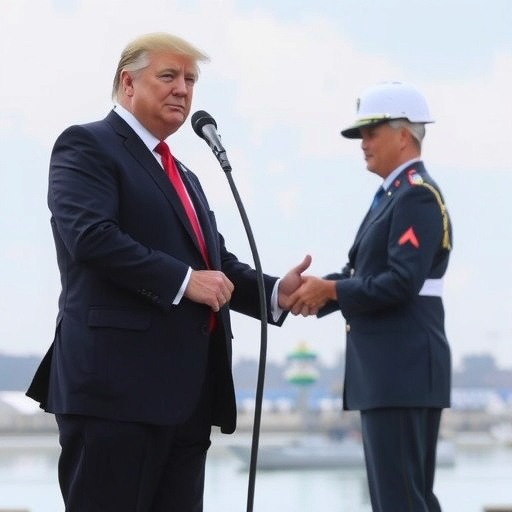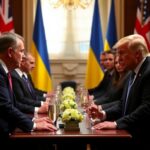Trump Hits Russia Hard: Sweeping Sanctions Target Oil Titans Rosneft and Lukoil Amid Ukraine Escalation
In a bold escalation of economic warfare, President Donald Trump has unleashed sweeping sanctions on Russia’s powerhouse oil companies, Rosneft and Lukoil, aiming to cripple Moscow’s energy sector and intensify pressure over the ongoing Ukraine conflict. Announced from the White House Rose Garden on a crisp autumn morning, the measures freeze U.S. assets of these giants and ban American firms from dealing with them, signaling a zero-tolerance stance against Russian aggression.
- Breaking Down the Sanctions: Asset Freezes and Trade Bans on Rosneft and Lukoil
- Ukraine Flashpoint: How Border Tensions Ignited Trump’s Aggressive Stance on Russia
- Oil Markets in Chaos: Brent Crude Spikes as Rosneft and Lukoil Face U.S. Wrath
- Analyst Breakdown: Economic Blows to Russia’s Core from Trump’s Sanctions Arsenal
- Horizon Watch: Retaliation Risks and Global Realignments After Targeting Rosneft and Lukoil
The decision comes as U.S. intelligence reports heightened Russian military movements near Ukraine’s borders, with Trump vowing to “starve the bear of its lifeblood—oil money.” This move builds on previous sanctions but targets the heart of Russia’s economy, which derives over 40% of its federal budget from energy exports. With Rosneft, the world’s largest publicly traded oil company by production, and Lukoil, a key player in global refining, now in the crosshairs, the ripples are already shaking international markets.
Breaking Down the Sanctions: Asset Freezes and Trade Bans on Rosneft and Lukoil
The core of Trump’s executive order prohibits any U.S. person or entity from engaging in transactions with Rosneft and Lukoil, including the export of petroleum products, technology transfers, and financial dealings. According to a Treasury Department fact sheet released alongside the announcement, these sanctions will immediately freeze over $10 billion in assets held by these companies in U.S. jurisdictions. “This isn’t just a slap on the wrist; it’s a chokehold on Russia’s economic engine,” stated Treasury Secretary Janet Yellen in a briefing, emphasizing the order’s scope.
Rosneft, state-controlled and led by CEO Igor Sechin—a close ally of President Vladimir Putin—produced 5.9 million barrels of oil per day in 2022, accounting for nearly half of Russia’s total output. The sanctions bar U.S. banks from processing payments to Rosneft, potentially disrupting its deals in Asia and Europe. Similarly, Lukoil, which operates in over 30 countries and boasts reserves of 13 billion barrels, faces bans on joint ventures with American partners, hitting its downstream operations hard. A Lukoil spokesperson called the measures “unjust and counterproductive,” but declined further comment.
To illustrate the breadth, consider the following key components of the sanctions:
- Financial Restrictions: No new loans or investments from U.S. sources, with existing contracts voided within 90 days.
- Energy Sector Bans: Prohibition on supplying drilling equipment or software to Rosneft and Lukoil facilities.
- Secondary Sanctions: Third-party countries risk penalties if they facilitate evasion, deterring allies like China from backfilling U.S. voids.
Historical context underscores the severity: Previous sanctions post-2014 Crimea annexation cost Russia an estimated $100 billion in lost revenue. This round, experts say, could double that figure, given the targeted firms’ dominance.
Ukraine Flashpoint: How Border Tensions Ignited Trump’s Aggressive Stance on Russia
The Ukraine crisis has been the powder keg for these sanctions. U.S. officials cite satellite imagery showing 100,000 Russian troops massed near Kyiv, echoing the 2022 buildup that led to invasion fears. President Trump, in his address, linked the measures directly to Moscow’s “provocations,” stating, “Russia‘s saber-rattling ends today. We’re hitting them where it hurts—their oil oligarchs.” This rhetoric aligns with bipartisan support in Congress, where a resolution backing the sanctions passed the Senate Foreign Relations Committee unanimously last week.
Ukraine’s President Volodymyr Zelenskyy praised the move in a video statement: “America’s resolve strengthens our defense against tyranny. These sanctions on Rosneft and Lukoil will echo across the front lines.” The conflict’s human toll—over 14,000 deaths since 2014, per UN estimates—adds emotional weight, with Trump invoking stories of displaced families to justify the economic hammer.
Geopolitically, this fits into a broader U.S. strategy to wean Europe off Russian energy. Post-2022 invasion, EU imports of Russian gas dropped 80%, but oil remains a sticking point. Trump’s sanctions aim to accelerate diversification, pressuring allies like Germany to accelerate LNG terminals. Russian Foreign Minister Sergey Lavrov dismissed the actions as “economic terrorism,” warning of retaliatory measures against U.S. interests.
Delving deeper, intelligence leaks suggest the sanctions were greenlit after a CIA assessment deemed Russian incursions into Donbas regions imminent. This isn’t isolated; it’s part of a cascade including cyber defenses and NATO reinforcements, painting a picture of comprehensive deterrence.
Oil Markets in Chaos: Brent Crude Spikes as Rosneft and Lukoil Face U.S. Wrath
Global commodity traders reacted swiftly, with Brent crude oil prices surging 5% to $85 per barrel within hours of the announcement—the highest in six months. Analysts attribute the volatility to fears of supply disruptions from Russia, the world’s second-largest exporter. Rosneft and Lukoil together supply 15% of Europe’s oil needs, and their isolation from U.S. markets could redirect flows to India and China, but at discounted prices that squeeze Moscow’s coffers.
Wall Street saw mixed signals: Energy stocks like ExxonMobil rose 3% on expectations of filled voids, while broader indices dipped 1% amid inflation worries. “These sanctions could add $10 to U.S. pump prices if prolonged,” warned Bob McNally, founder of Rapidan Energy Group, in a CNBC interview. He noted that Rosneft‘s Arctic drilling projects, reliant on Western tech, might halt, reducing global supply by 500,000 barrels daily.
Statistics paint a stark picture:
- Russian Export Impact: Pre-sanctions, Russia exported 7.5 million barrels per day; new barriers could slash this by 20%.
- Lukoil’s Global Footprint: With refineries in the U.S. and Europe, the company reported $120 billion in 2022 revenue—now at risk.
- Market Projections: Goldman Sachs forecasts a 10-15% hike in heating oil costs this winter, hitting consumers from Texas to Tokyo.
Environmental angles emerge too: Sanctions might slow Rosneft‘s controversial Siberian expansions, which environmentalists decry for methane emissions equivalent to 100 coal plants annually. Yet, some green advocates worry short-term boosts to U.S. shale could undermine climate goals.
Analyst Breakdown: Economic Blows to Russia’s Core from Trump’s Sanctions Arsenal
Economic experts are unanimous: These sanctions strike at Russia‘s vulnerabilities. The ruble plummeted 7% against the dollar post-announcement, and Moscow’s stock exchange halted trading on energy shares. “Rosneft and Lukoil are the arteries of Putin’s war machine,” said Anders Åslund, a senior fellow at the Atlantic Council. “Losing U.S. access could cost Russia $50 billion yearly, forcing budget cuts or debt spirals.”
Inside Russia, whispers of dissent grow. Lukoil‘s board, already at odds with the Kremlin over Ukraine, might see shareholder revolts. A leaked memo from Rosneft executives reportedly urges diversification to BRICS partners, but experts doubt its feasibility amid SWIFT exclusions.
Quotes from the frontlines: OPEC Secretary General Haitham Al Ghais called for dialogue to stabilize prices, while EU Energy Commissioner Kadri Simson affirmed, “We stand with the U.S. in isolating Russian aggressors.” Domestically, U.S. Chamber of Commerce voiced concerns over supply chain hits, estimating 50,000 American jobs in energy tied to Russian ties.
Longer-term, think tanks like the Brookings Institution project a 2-3% GDP contraction for Russia in 2024, exacerbating inflation at 8%. For Trump, it’s a political win, bolstering his tough-on-foreign-policy image ahead of midterms.
Horizon Watch: Retaliation Risks and Global Realignments After Targeting Rosneft and Lukoil
Looking ahead, the sanctions on Rosneft and Lukoil could reshape alliances. Moscow might accelerate the Nord Stream 2 pipeline bypasses or deepen ties with Iran, flooding markets with discounted crude and undercutting U.S. influence. Putin has hinted at asymmetric responses, from cyberattacks on energy grids to export curbs on rare earths vital for U.S. tech.
Internationally, NATO summits next month will likely expand coordinated measures, with Britain and Canada mulling parallel bans. For Ukraine, the economic pressure buys time for fortifications, potentially deterring invasion. U.S. diplomats are lobbying G7 partners for unity, aiming to isolate Russia further.
Domestically, Trump faces blowback from oil-dependent states like Texas, where governors urge exemptions for legacy deals. Yet, polls show 65% American approval for tough sanctions, per Gallup. As winter looms, the true test will be supply resilience—will OPEC+ step up, or will global recession fears mount?
In essence, these measures herald a new era of energy geopolitics, where sanctions aren’t just punitive but pivotal in curbing Russia‘s ambitions. Stakeholders from Kyiv to Wall Street brace for aftershocks, with the oil majors’ fate hanging in the balance.









